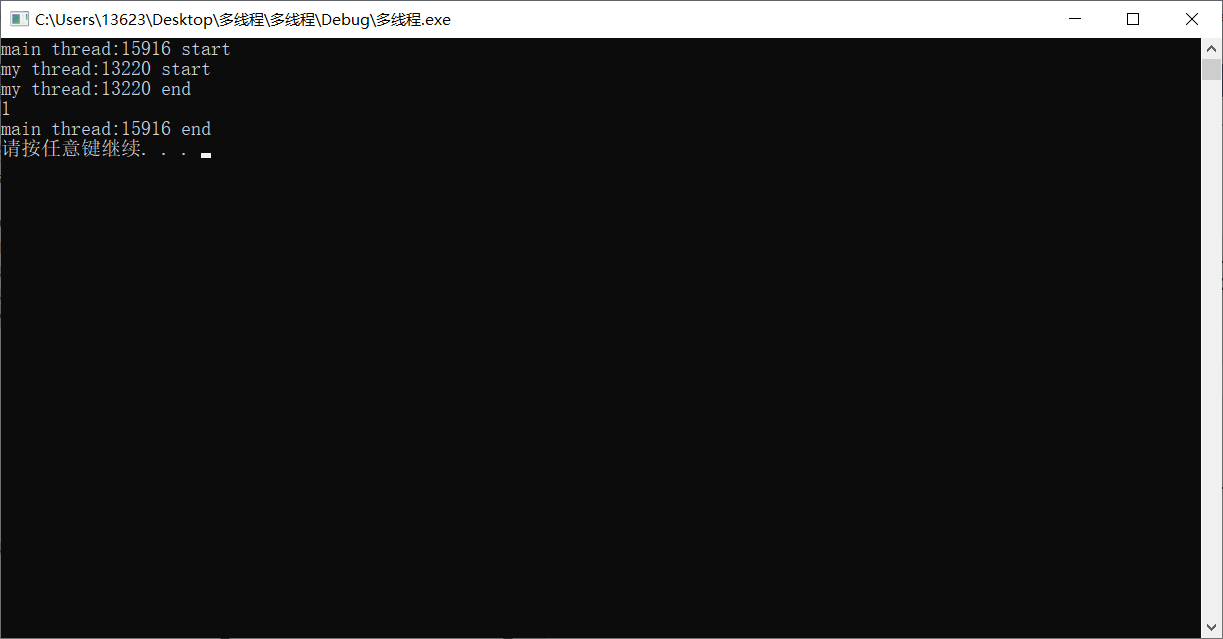C++多线程基础学习笔记(七)
一、std::async和std::future的用法
std::async是一个函数模板,std::future是一个类模板
#include <iostream>
#include <thread>
#include <future>
#include <Windows.h> using namespace std; int mythread()
{
cout << "my thread:" << std::this_thread::get_id() << " start" << endl;
int temp = ;
temp++;
Sleep();
cout << "my thread:" << std::this_thread::get_id() << " end" << endl;
return temp;
}
int main()
{
cout << "main thread:" << std::this_thread::get_id() << " start" << endl;
std::future<int> result = std::async(std::launch::async, mythread);
//std::async(mythread);相当于std::async(std::launch::async|std::lauch::deferred, mythread);
//自动创建一个线程开始执行线程入口函数,并返回一个std::future对象给result cout << result.get() << endl; //等待入口函数执行,直到拿到返回值,即temp
//result.wait(); //只等待入口函数执行完,但不返回结果
cout << "main thread:" << std::this_thread::get_id() << " end" << endl;
system("pause");
return ;
}

std::async(std::launch::async, mythread);如果std::async()的第一个参数改成std::lauch::deferred,那么线程不会被马上执行,而是延迟到std::future的wait()或者get()函数调用时才执行线程的入口函数。实际上,并没有创建
子线程,而只是在主函数中调用了入口函数。
二、std::packaged_task的用法
std::packaged_task是一个类模板,模板参数各种可调用对象,通过它把各种可调用对象包装起来,方便作为线程入口函数来调用
#include <iostream>
#include <thread>
#include <future>
#include <Windows.h> using namespace std; int fun(int val)
{
cout << "my thread:" << std::this_thread::get_id() << " start" << endl;
val++;
cout << "my thread:" << std::this_thread::get_id() << " end" << endl;
return val;
}
int main()
{
cout << "main thread:" << std::this_thread::get_id() << " start" << endl;
std::packaged_task<int(int)> pack(fun);
thread t1(std::ref(pack), );
t1.join();
std::future<int> result = pack.get_future();
cout << result.get() << endl;
cout << "main thread:" << std::this_thread::get_id() << " end" << endl;
system("pause");
return ;
}
三、std::promise的用法
std::promise是一个类模板,能够在某个线程中给它赋值,然后可以在其他线程中,在将来的某个时刻,可以把这个值取出来。
#include <iostream>
#include <thread>
#include <future>
#include <Windows.h> using namespace std; void mythread1(std::promise<int> &pro, int val)
{
cout << "my thread1:" << std::this_thread::get_id() << " start" << endl;
val++;
val--;
Sleep(); //假设运算了500毫秒
int result = val;
pro.set_value(val);//保存结果
cout << "my thread1:" << std::this_thread::get_id() << " end" << endl;
} void mythread2(std::future<int> &getful)
{
cout << "my thread2:" << std::this_thread::get_id() << " start" << endl;
auto getval = getful.get();
cout << getval << endl;
cout << "my thread2:" << std::this_thread::get_id() << " end" << endl;
}
int main()
{
cout << "main thread:" << std::this_thread::get_id() << " start" << endl;
std::promise<int> prom; //声明一个promise对象,保存类型为int
thread t1(mythread1, std::ref(prom), );
t1.join(); std::future<int> ful = prom.get_future(); //promise和future绑定,用于返回保存的结果 //在主线程获取结果
//auto result = ful.get(); //get()只能使用一次,如果主线程中使用了,t2就不能使用了
//cout << result << endl; //在线程t2中获取结果
thread t2(mythread2, std::ref(ful));
t2.join(); cout << "main thread:" << std::this_thread::get_id() << " end" << endl;
system("pause");
return ;
}
std::ref 用于包装按引用传递的值。
C++多线程基础学习笔记(七)的更多相关文章
- Java基础学习笔记七 Java基础语法之继承和抽象类
继承 继承的概念 在现实生活中,继承一般指的是子女继承父辈的财产.在程序中,继承描述的是事物之间的所属关系,通过继承可以使多种事物之间形成一种关系体系. 例如公司中的研发部员工和维护部员工都属于员工, ...
- C++多线程基础学习笔记(四)
一.创建多个子线程 前面三章讲的例子都是只有一个子线程和主线程,然而实际中有多个子线程.那么下面介绍如何创建多个子线程. #include <iostream> #include < ...
- C++多线程基础学习笔记(一)
下面分三个方面多线程技术的必须掌握一些基本知识. 1.进程 2.线程 3.并发 (1)进程 一个可执行程序运行起来了,即为创建了一个进程.如在电脑上打开了word,就创建了一个word进程,打开QQ, ...
- loadrunner基础学习笔记七-面向目标场景
部署应用程序之前,要执行验收测试以确保系统能够承担预期的实际工作量. 可以为想要生成的每秒点击次数,每秒事务数或事务响应时间设置目标 loadrunner将使用面向目标的场景自动生成所需的目标,当应用 ...
- JDBC一(web基础学习笔记七)
一.JDBC Java数据库的连接技术(Java DataBase Connectivity),能实现Java程序以各种数据库的访问 由一组使用Java语言编写的类和接口(JDBC API)组成,它j ...
- C++多线程基础学习笔记(十)
一.Windows临界区的基本用法 CRITICAL_SECTION my_winsc; //定义一个Windows的临界区,相当于一个mutex变量 InitializeC ...
- C++多线程基础学习笔记(九)
一.std::atomic续谈 上一章说到std::atomic是针对一个变量的,这里补充一下针对的变量操作一般是++,+=,--,&=等等运算 .以下这种不可取:a=a+1; 二.std:: ...
- C++多线程基础学习笔记(八)
shared_futrue和futrue_status的用法 shared_futrue是一个类模板,类似于futrue,不同的是它的成员函数get()可以使用多次,因为是复制数据,而futrue的g ...
- C++多线程基础学习笔记(六)
condition_variable.wait.notifiy_one.notify_all的使用方式 condition_variable:条件变量 wait:等待被唤醒 notify_one:随机 ...
随机推荐
- 【原创】LUOGU P1808 单词分类
STL大法好!!! 使用sort()将string排序,map去重并统计即可. 最短代码如下: #include<bits/stdc++.h> using namespace std; s ...
- 转:玩转HTML5移动页面(动效篇)
作为一名前端,在拿到设计稿时你有两种选择: 1.快速输出静态页面 2.加上高级大气上档次狂拽炫酷屌炸天的动画让页面动起来 作为一个有志向的前端,当然是选2啦!可是需求时间又很短很短,怎么办呢? 这次就 ...
- linux 动态库文件stripped属性理解
[file命令not stripped] UNIX下*.o和*.so文件显示的stripped和not stripped是什么意思? 表示符号表是否被清除. 在centos 6.2下用file命令查看 ...
- 树状数组(BIT)
树状数组 树状数组是在线段树的结构上改造而来数据结构,主要用于完成: 给定一个初始值全为0的数列 ①给定i,计算返回a1+a2+--+ai的值 ②给定i和x,执行ai+=x BIT的求和 ll sum ...
- Java集成POI进行Excele的导入导出,以及报错: java.lang.AbstractMethodError..........
报错信息如下 java.lang.AbstractMethodError: org.apache.poi.xssf.usermodel.XSSFCell.setCellType(Lorg/apache ...
- TCP输入 之 tcp_queue_rcv
tcp_queue_rcv用于将接收到的skb加入到接收队列receive_queue中,首先会调用tcp_try_coalesce进行分段合并到队列中最后一个skb的尝试,若失败则调用__skb_q ...
- TCP输入 之 tcp_prequeue
在未开启tcp_low_latency的情况下,软中断将skb送上来,加入到prequeue中,然后 在未启用tcp_low_latency且有用户进程在读取数据的情况下,skb入队到prequeue ...
- SpringBoot集成prometheus
1.Prometheus 1)介绍 Prometheus是一套开源的监控&报警&时间序列数据库的组合,基于应用的metrics来进行监控的开源工具 . 架构图: 2)下载 https: ...
- 爬取百度网盘资源报user is not authorized, hitcode:119
爬取百度网盘资源报user is not authorized, hitcode:119 一.总结 一句话总结: 可能是百度网盘禁止非客户端环境下载大文件,所以将请求头改为客户端:'User-Agen ...
- 报错:SQLSTATE[23000]: Integrity constraint violation: 1062 Duplicate entry 'admin' for key 'username'
在提交注册信息的时候报错:SQLSTATE[23000]: Integrity constraint violation: 1062 Duplicate entry 'admin' for key ' ...
